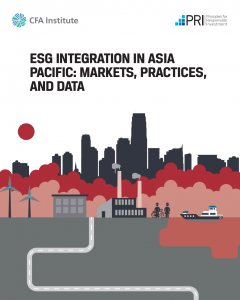
Download here: https://www.cfainstitute.org/en/research/survey-reports/esg-integration-apac
- The impact of ESG factors on capital markets and investment practices.
- Drivers of and barriers to ESG integration
- Trends in ESG company data
- Investment Practices of Local Practitioner: Equities and fixed income
- Interview with major market player.
Methodology
To better understand how ESG factors impact the capital markets (share prices, corporate bond spreads, and sovereign debt yields) and how frequently investors do and do not integrate ESG data in their investment analysis and process, the firm YouGov was commissioned to administer a global survey on ESG integration. The survey asked questions to gauge investor attitudes toward ESG integration as well as to obtain a better understanding of how ESG integration is done in practice. Research was carried out among stakeholders in 17 different markets. The findings for respondents in the APAC region are based upon 339 completed surveys from respondents based in:
- Australia (n=36);
- China (n=40);
- Hong Kong SAR (n=80);
- India (n=42);
- Japan (n=91);
- Singapore (n=50).
Key Findings
Our main findings include the following points:
- There is no “one best way” to do ESG integration and no “silver bullet” to ESG integration.
- Governance is the ESG factor most investors are integrating into their process.
- Environmental and social factors are gaining acceptance, but from a low base.
- ESG integration is further along in the equity world than in fixed income.
- Portfolio managers and analysts are more frequently integrating ESG into the investment process but are rarely adjusting their models based on ESG data.
- The main drivers of ESG integration are risk management and client demand.
- The main barriers to ESG integration are a limited understanding of ESG issues and a lack of comparable ESG data.
- Investors acknowledge that ESG data has come a long way, but advances in quality and comparability of data still have a long way to go.
- It would be helpful for issuers and investors to agree upon a single ESG reporting standard that could streamline the data-collection process and produce more quality data.
- Many workshop participants were concerned that ESG mutual funds and exchange traded funds (ETFs) offered to investors may be driven by marketing decisions and may not be true ESG investment products.
Looking for more research and resources on ESG? Check out our ESG Investing and Analysis hub.







